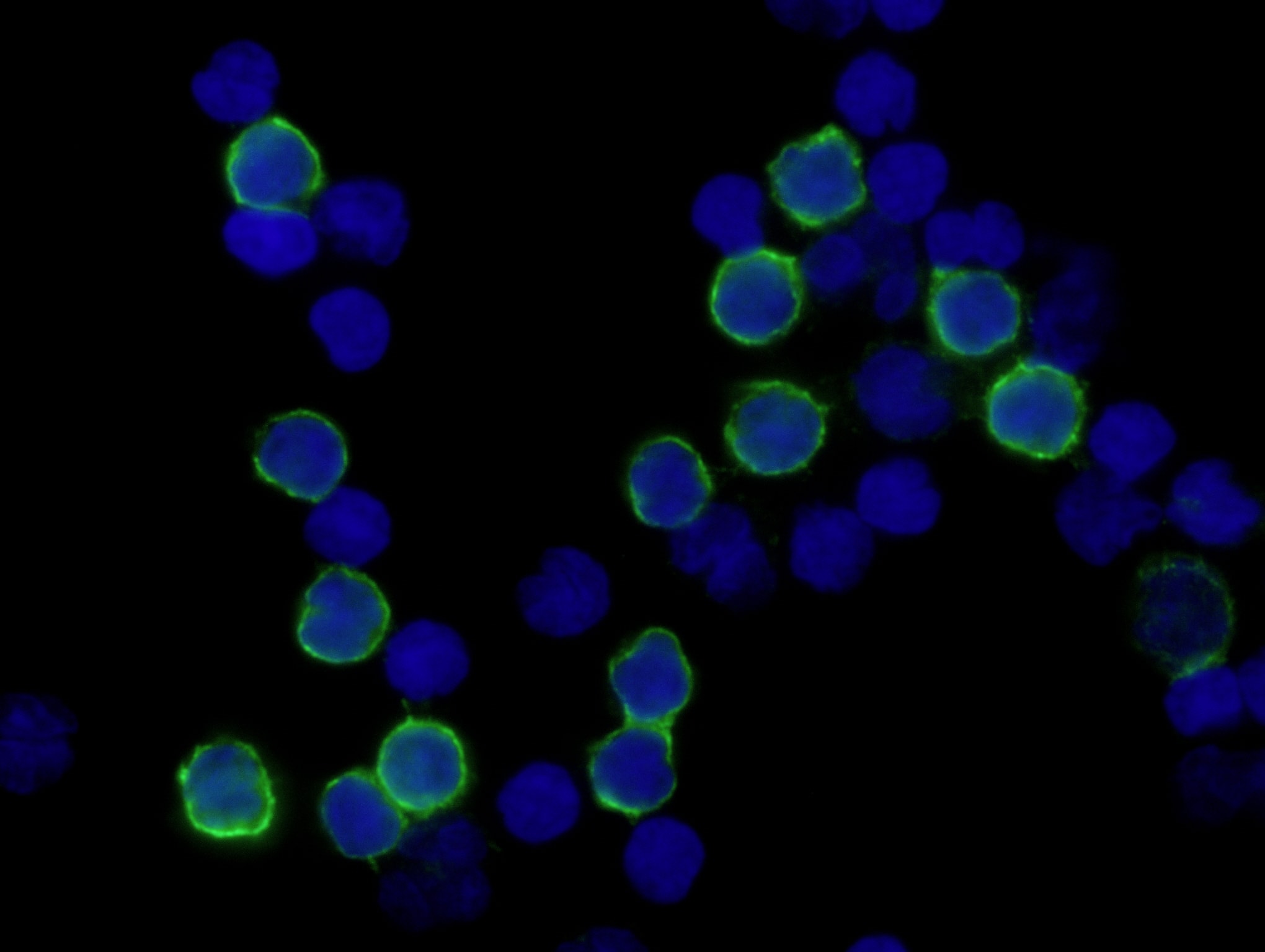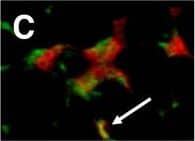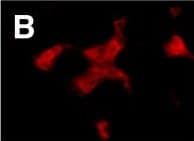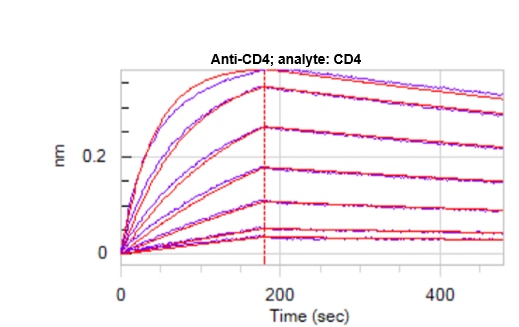Human CD4 Antibody Summary
Extracellular domain
Applications
Please Note: Optimal dilutions should be determined by each laboratory for each application. General Protocols are available in the Technical Information section on our website.
Scientific Data
 View Larger
View Larger
CD4 in Human PBMCs. CD4 was detected in immersion fixed human peripheral blood mononuclear cells (PBMCs) using Mouse Anti-Human CD4 Monoclonal Antibody (Catalog # MAB379) at 10 µg/mL for 3 hours at room temperature. Cells were stained using the NorthernLights™ 493-conjugated Anti-Mouse IgG Secondary Antibody (green; Catalog # NL009) and counterstained with DAPI(blue). Specific staining was localized to the cell surface. View our protocol for Fluorescent ICC Staining of Non-adherent Cells.
 View Larger
View Larger
Detection of Human CD4 by Immunocytochemistry/Immunofluorescence CX3CR1 expressions in affected muscle of patients with polymyositis. The muscle tissues of polymyositis (PM) patients were double-stained with CD4, CD8, or CD68, as well as CX3CR1, and were analyzed with fluorescent microscopy: (A) CX3CR1, (B) CD4, (C) merged (A) and (B), (D) CX3CR1, (E) CD8, (F) merged (D) and (E), (G) CX3CR1, (H) CD68, and (I) merged (G) and (H). Arrows indicate double-positive cells. Original magnification, ×400. Image collected and cropped by CiteAb from the following publication (https://arthritis-research.biomedcentral.com/articles/10.1186/ar3761), licensed under a CC-BY license. Not internally tested by R&D Systems.
 View Larger
View Larger
Detection of Human CD4 by Immunocytochemistry/Immunofluorescence CX3CR1 expressions in affected muscle of patients with polymyositis. The muscle tissues of polymyositis (PM) patients were double-stained with CD4, CD8, or CD68, as well as CX3CR1, and were analyzed with fluorescent microscopy: (A) CX3CR1, (B) CD4, (C) merged (A) and (B), (D) CX3CR1, (E) CD8, (F) merged (D) and (E), (G) CX3CR1, (H) CD68, and (I) merged (G) and (H). Arrows indicate double-positive cells. Original magnification, ×400. Image collected and cropped by CiteAb from the following publication (https://arthritis-research.biomedcentral.com/articles/10.1186/ar3761), licensed under a CC-BY license. Not internally tested by R&D Systems.
Preparation and Storage
- 12 months from date of receipt, -20 to -70 °C as supplied.
- 1 month, 2 to 8 °C under sterile conditions after reconstitution.
- 6 months, -20 to -70 °C under sterile conditions after reconstitution.
Background: CD4
CD4 is an approximately 55 kDa type I membrane glycoprotein that is expressed predominantly on most thymocytes and a subset of mature T lymphocytes. In humans, CD4 is also expressed to a lesser extent on monocytes and macrophage related cells. Human CD4 cDNA encodes a 458 amino acid (aa) precursor protein with a 25 aa signal peptide, a 371 aa extracellular region containing four immunoglobulin homology domains, a 24 aa transmembrane domain and a 38 aa cytoplasmic domain. CD4 is a coreceptor required for T cell recognition of antigens that are presented by class II major histocompatibility complexes. CD4 has been shown to be a coreceptor of HIV entry and specifically binds gp120, the external envelope glycoprotein of HIV.
Product Datasheets
Citations for Human CD4 Antibody
R&D Systems personnel manually curate a database that contains references using R&D Systems products. The data collected includes not only links to publications in PubMed, but also provides information about sample types, species, and experimental conditions.
11
Citations: Showing 1 - 10
Filter your results:
Filter by:
-
Cerebrospinal fluid markers reveal intrathecal inflammation in progressive multiple sclerosis.
Authors: Komori M, Blake A, Greenwood M et al.
Ann Neurol
-
Thrombospondin‑2 is upregulated in patients with aortic dissection and enhances angiotensin II‑induced smooth muscle cell apoptosis
Authors: Liping Qi, Kui Wu, Shutian Shi, Qingwei Ji, Huangtai Miao, Que Bin
Experimental and Therapeutic Medicine
-
Role of IL-17A in Chronic Rhinosinusitis With Nasal Polyp
Authors: Gwanghui Ryu, Jun-Sang Bae, Ji Hye Kim, Eun Hee Kim, Lele Lyu, Young-Jun Chung et al.
Allergy, Asthma & Immunology Research
-
Infiltration and persistence of lymphocytes during late-stage cerebral ischemia in middle cerebral artery occlusion and photothrombotic stroke models
Authors: Y Feng, S Liao, C Wei, D Jia, K Wood, Q Liu, X Wang, FD Shi, WN Jin
J Neuroinflammation, 2017-12-15;14(1):248.
Species: Human
Sample Types: Whole Tissue
Applications: IHC -
Tumor microenvironment contributes to Epstein-Barr virus anti-nuclear antigen-1 antibody production in nasopharyngeal carcinoma
Authors: P Ai, Z Li, Y Jiang, C Song, L Zhang, H Hu, T Wang
Oncol Lett, 2017-06-22;14(2):2458-2462.
Species: Human
Sample Types: Whole Tissue
Applications: IHC-P -
Kv1.3 channels mark functionally competent CD8+ tumor infiltrating lymphocytes in head and neck cancer
Cancer Res., 2016-11-04;0(0):.
Species: Human
Sample Types: Whole Tissue
Applications: IHC -
Serum level of soluble CX3CL1/fractalkine is elevated in patients with polymyositis and dermatomyositis, which is correlated with disease activity.
Authors: Suzuki F, Kubota T
Arthritis Res. Ther., 2012-03-06;14(2):R48.
Species: Human
Sample Types: Whole Tissue
Applications: IHC-Fr -
The Scaffolding Protein Dlg1 Is a Negative Regulator of Cell-Free Virus Infectivity but Not of Cell-to-Cell HIV-1 Transmission in T Cells
Authors: Patrycja Nzounza, Maxime Chazal, Chloé Guedj, Alain Schmitt, Jean-Marc Massé, Clotilde Randriamampita et al.
PLoS ONE
-
The transmembrane domain of the severe acute respiratory syndrome coronavirus ORF7b protein is necessary and sufficient for its retention in the Golgi complex.
Authors: Schaecher SR, Diamond MS, Pekosz A
J. Virol., 2008-07-16;82(19):9477-91.
Species: Human
Sample Types: Cell Lysates, Whole Cells
Applications: Flow Cytometry, ICC, Western Blot -
Presence of IgG-CD4 complexes in the circulation.
Authors: Nezlin R, Bengtsson AA
Immunol. Invest., 2008-01-01;37(2):153-62.
Species: Human
Sample Types: Serum
Applications: Dot Blot -
Potentials and capabilities of the Extracellular Vesicle (EV) Array.
Authors: Jorgensen MM, Baek R, Varming K.
J Extracell Vesicles
FAQs
No product specific FAQs exist for this product, however you may
View all Antibody FAQsReviews for Human CD4 Antibody
Average Rating: 4 (Based on 2 Reviews)
Have you used Human CD4 Antibody?
Submit a review and receive an Amazon gift card.
$25/€18/£15/$25CAN/¥75 Yuan/¥2500 Yen for a review with an image
$10/€7/£6/$10 CAD/¥70 Yuan/¥1110 Yen for a review without an image
Filter by:







